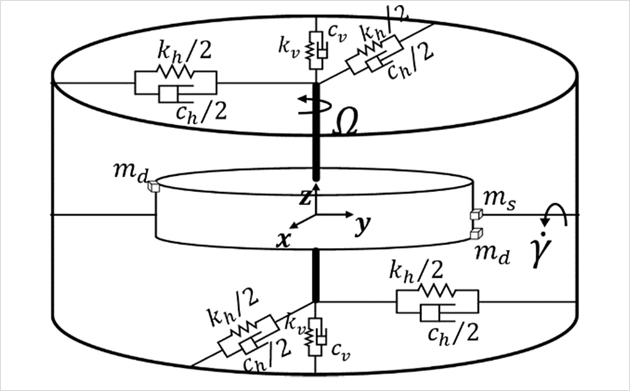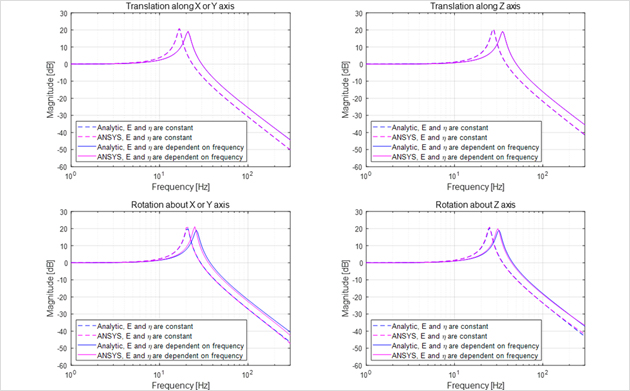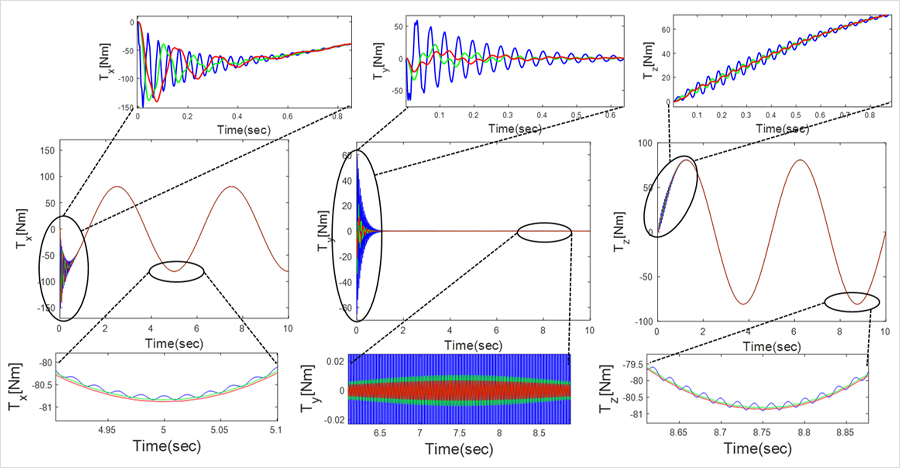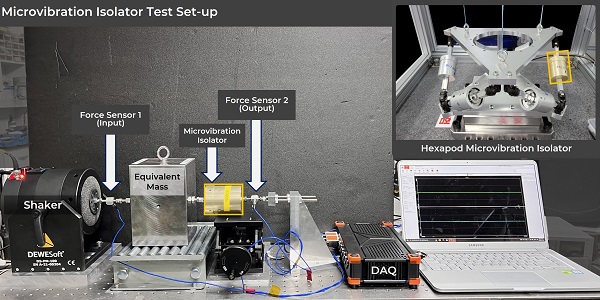e. Vibration Isolator Analysis
Shock & Vibration Control

 Research
Research
 Shock & Vibration Control
Shock & Vibration Control
 e. Vibration Isolator Analysis
e. Vibration Isolator Analysis
b. Vibration Isolator Analysis
Principal Investigator: Jae-Hung Han
Participating Graduate Research Assistants: Ba-Woul Chung, Seung-Chan Lee
Related Projects: LIG Nex1
Summary:
As the recent space missions have become more challenging, mission equipment such as optical payloads, im- aging radar, and other equipment mounted on a satellite is required to have high performance. Various mission equipment and components are exposed to continuous vibration. In order to ensure precision pointing stability, it is essential to reduce the vibration transmitted to the satellite from the vibration source. Since the passive vibration isolation is easy to implement and more cost-effective than active or semi-active methods, it has been used as the typical method to isolate the vibration. Especially, in case of using a viscoelastic material, there is an advantage that a roll-off rate at high frequency is not affected by a damping value unlike conventional passive system composed of spring and damper in parallel. In this study, a vibration isolator is designed to reduce the micro-vibration generated by the control moment gyroscope using the viscoelastic material. A mathematical model, which can describe the performance of the isolator is established in six degrees of freedom: three translational and three rotational motions. In order to evaluate the amount of reduction in micro-vibration through the viscoelastic material, the equation of force and moment transmissibility are established. Finally, the mathematical model for vibration isolator is verified by comparing the transmissibility plots with ANSYS results.Related Recent Publication:
- [1] Yoon, D.-H., Suh, J.-E., and Han, J.-H., “Mathematical Modeling of Vibration Isolator for Control Moment Gyroscope,” 14th International Conference on Motion and Vibration, Daejeon, Korea, Aug. 05-08, 2018. [DOI]
- [2] Yoon, D.-H., Suh, J.-E., and Han, J.-H., Seo, J., and Song, D.-K., “Mathematical Modeling of Vibration Isolator Employing Viscoelastic Material,” Trans. Korean Soc. Noise Vib. Eng., Vol. 28, No. 4, pp. 440-450, 2018. [DOI]
- [3] Yoon, D.-H., “A Study on Vibration isolation for Control Moment Gyroscope using Viscoelastic Material,” KAIST, Master’s Thesis, 2019.
Development of Vibration isolator system for space structure
1.Goals
- Modeling the Vibration Isolator using Viscoelastic Material in order to reduce the micro-vibration caused by Control Moment Gyroscope (CMG).
2. Approaches
Establish the mathematical model of the CMG including the unbalance of the flywheel in order to analyze the characteristics of the micro-vibration generated by the vibration source.- The model considers not only the small displacement in the radial displacement of the flywheel but also in the axial direction of the wheel.
- In order to more accurately analyze the disturbance characteristics due to the unbalanced mass, the effect of coupling the displacement in the translational direction and the displacement in the rotational direction is considered.

Fig.1 The dynamical model of the CMG
- Since the micro-vibration caused by the CMG has low amplitude, linear analysis is performed.
- Equation of transmissibility for 6-DOF is established.

Fig.2 Verification for the mathematical model of the CMG by comparing the torque transmitted to the gimbal
- Considering the Poisson’s ratio of the viscoelastic material is nearly 0.5, instead of Young’ Modulus, Effective Compression Modulus is used.
- The frequency dependent Modulus (Young’s Modulus, Shear Modulus, Loss factor…) is used.
- Assuming that temperature control is possible, the effect of temperature on the viscoelastic material’s Modulus is ignored.
- The natural frequency of the proposed isolator is determined based on the frequency analysis of the force and torque generated by driving of the CMG.

Fig.3 Transmissibility of the vibration isolator
3. Research Achievements
Verify the mathematical model of the CMG by using ADAMS.- The force and torque transmitted to the gimbal due to the driving of the CMG are compared with the results of ADAMS.
- Using the mathematical model and ANSYS result, the mathematical model for the vibration isolator is validated by comparing the force transmissibility and moment transmissibility plots.
- Parameteric study on dimension and Modulus of the viscoelastic material is conducted.
- The optimal value of parameters is determined through 2 process, and it can minimize the vibration in both the transient and steady state.

Fig.4 Results of the torque transmitted to the satellite (Blue line : There is no vibration isolator, Green line : The design parameter is one of the values selected in the mid-process of optimization, Red line : The design parameter is the final value determined through optimization)

Fig.5 Vibration isolator system













